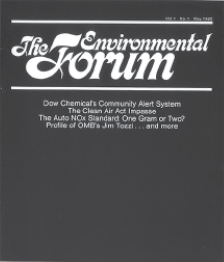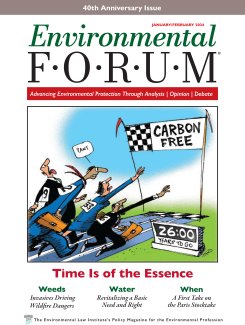Starting with the January/February 2024 issue, the Environmental Forum has a change: “The,” capitalized and in italics, is no longer part of our name—too 20th century, to be frank. This change comes as a result of celebrating our 40th anniversary with this issue, a time for reflection as to the foundational purposes behind this publication and to honor the roster of leading professionals who have made it possible. There are on average 25 individuals of highly varying views who contribute to each issue.

Few magazines live into their fifth decade, so the very fact that members can hold this issue in their hands is remarkable from a publishing point of view. Over that time, five ELI presidents have been listed on our masthead as publisher, an arrangement that is deliberately hands-off. They have allowed me to exercise my judgment as a journalist and editorial professional, with much advice from our editorial board and other experts, as to what content will benefit an environmental professional.
That arrangement can be uncomfortable at times, because dialogue among the profession is part of our mission—and opinions can disagree sharply. But the name was not chosen accidentally at the birth of the magazine. ELI saw in its membership publication a chance to advance its own mission, which in part is to serve as a “convening forum” for stakeholders.

This function, which results in seeing a variety of viewpoints, can be upsetting, given the multiplicity of conflicting and overlapping interests. But it is necessary in getting anything done in the field of environmental protection, where so many have something at stake, and interests are often in competition.
We take advantage of this tension and in fact encourage its expression throughout the magazine, in the hope of moving the ball forward. In our bimonthly Debates and via the Sidebar articles that accompany our major features, we create dialogue on the crucial issues facing environmental protection.
On average, there are 10 such single-page viewpoint articles in every issue, along with the four big viewpoint articles composing our feature well. In addition, we have eight expert columnists and reviewers at work, covering a range of beats across the profession. That’s a lot of opinion, analysis, and debate—the big three attributes we are proudest of, flagged in the logo on every cover.
Speaking of that banner, “Advancing environmental protection” has always been central to ELI’s mission and is the main component of the Forum’s mission as well—the convening function supports the advancing function, which is our core purpose. Speaking as a journalist, I’m very comfortable with that task. Nothing can be more rewarding to a professional writer and editor than helping to save the planet. And to be able to speak directly to you, the profession engaged in that work, via my bimonthly column. It’s been a privilege.
This is the 200th iteration of my Notice & Comment column over the more than 33 years since I’ve been editor. A lot has changed in that third of a century. For one thing, Congress has stopped passing major environmental legislation. Indeed, the 1990 amendments to the Clean Air Act, signed in my first year at the Forum, constituted the last major reauthorization till the amendments to the Toxic Substances Control Act were signed in 2016. And that law passed only because stakeholders were unanimous in condemning its predecessor—so it wasn’t an advance as much as calling off a retreat.
As Bud Ward describes in his memoir on the founding of the magazine elsewhere in the January/February 2024 issue, the Forum became famous in the early 1980s by depicting environmental legislation in progress as a horse race involving a roster of half a dozen pollution bills vying for passage. The sense is one of speed and progress (although some of these graphics showed one horse representing a bill facing challenges as running the wrong way).
The notion of Congress as a breeding ground for important change in serving society’s needs no longer permeates our pages. Today if there were to be a derby graphic, it would have to depict the progress of rules fleshing out those ancient foundational statutes—not just in the agencies but in the courts as well.
For the executive branch, rulemaking today is less a horse race and more of a steeplechase, with hurdles and water hazards, requiring stamina and the ability to master a number of challenges. Adding in the role of the judiciary, it’s also like figure skating, with its required skill elements and panel of subjective judges.
Whatever the metaphor, covering that competition in detail is not the Forum’s task. See ELR, our sister publication, for that. Rather, the publication does what only a policy magazine can do—provide a rich and varied buffet on the issues of today and tomorrow. We’ve been doing it for 40 years now. Thanks for your support!
This blog is adapted from the Notice and Comment column of the Jan/Feb 2024 issue of the Environmental Forum. Notice & Comment is the editor’s column and represents his views. It is republished with permission.
